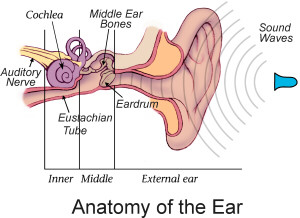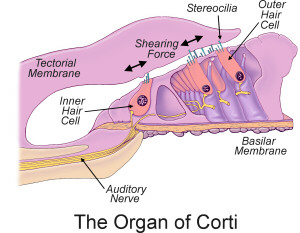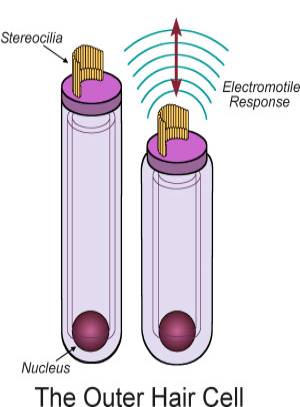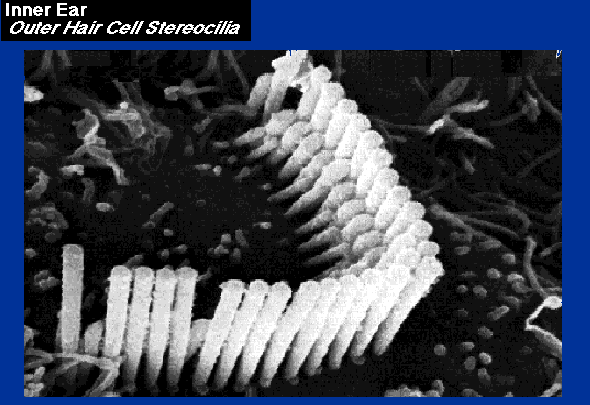¡@
Outer Hair Cells Physiology

The ear has three divisions: the external ear, the middle ear, and the inner ear. The external ear collects sound waves and funnels them down the ear canal, where they vibrate the eardrum. Within the middle ear, the eardrum is connected to the middle ear bones. These are the smallest bones in the body, and they mechanically carry the sound waves to the inner ear. The eustachian tube connects the middle ear to the upper part of the throat, equalizing the air pressure within the middle ear to that of the surrounding environment. The inner ear contains the cochlea. This is the organ that converts sound waves into neural signals. These signals are passed to the brain via the auditory nerve.

Coiling around the inside of the cochlea, the organ of Corti contains the cells responsible for hearing, the hair cells. There are two types of hair cells: inner hair cells and outer hair cells. These cells have stereocilia or "hairs" that stick out. The bottom of these cells are attached to the basilar membrane, and the stereocilia are in contact with the tectorial membrane. Inside the cochlea, sound waves cause the basilar membrane to vibrate up and down. This creates a shearing force between the basilar membrane and the tectorial membrane, causing the hair cell stereocilia to bend back and forth. This leads to internal changes within the hair cells that creates electrical signals. Auditory nerve fibers rest below the hair cells and pass these signals on to the brain. So, the bending of the stereocilia is how hair cells sense sounds.

Outer hair cells have a special function within the cochlea. They are shaped cylindrically, like a can, and have stereocilia at the top of the cell, and a nucleus at the bottom. When the stereocilia are bent in response to a sound wave, an electromotile response occurs. This means the cell changes in length. So, with every sound wave, the cell shortens and then elongates. This pushes against the tectoral membrane, selectively amplifying the vibration of the basilar membrane. This allows us to hear very quiet sounds. The electromotile response of an outer hair cell is shown in the movie:
Click here to see Quicktime Movie (660 KB)
When you are exposed to loud music or noise, it is your hair cells which are damaged. Hearing loss occurs because loud sounds are really just large pressure waves (like when you stand next to a subwoofer and can "feel" the bass). These large pressure waves bend the stereocilia too far, sometimes to the point where they are damaged. This kills the hair cell. Since cochlear hair cells can not grow back, this manifests as a permanent hearing loss.
The outer hair cell Stereo cilia

The URL of this page are¡G
http://www.neurophys.wisc.edu/h&b/auditory/anatomy/a05.html
http://www.bcm.tmc.edu/oto/research/cochlea/Hearing/index.html